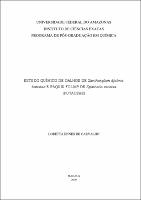| ???jsp.display-item.social.title??? |


|
Please use this identifier to cite or link to this item:
https://tede.ufam.edu.br/handle/tede/3321| ???metadata.dc.type???: | Dissertação |
| Title: | Estudo químico de galhos de Zanthoxylum djalma-batistae e ráquis foliar de Spathelia excelsa (Rutaceae) |
| ???metadata.dc.creator???: | Carvalho, Loretta Ennes de  |
| ???metadata.dc.contributor.advisor1???: | Lima, Maria da Paz |
| ???metadata.dc.description.resumo???: | A família Rutaceae apresenta uma grande diversidade de metabólitos secundários, com potencial biológico e/ou farmacêutico, o que tem despertado interesse nos estudos de suas espécies. Apesar da Amazônia possuir uma grande diversidade de espécies pertencentes a esta família, existem poucos trabalhos envolvendo a identificação de seus metabólitos secundários. Visando contribuir para o conhecimento do perfil químico da família na região, selecionou-se para este estudo as espécies Zanthoxyllum djalma-batistae (Albuq.) P.G. Waterman e Spathelia excelsa (Krause) R.S. Cowan & Brizicky. Assim, coletaram-se galhos de Z. djalma-batistae e ráquis foliares de S. excelsa de indivíduos ocorrentes na Reserva Ducke, para estudos fitoquímicos. O extrato metanólico dos galhos de Z. djalma-batistae foi submetido a uma partição, originando 4 fases orgânicas. As fases em hexano e diclorometano, após sucessivos fracionamentos cromatográficos forneceram a mistura dos triterpenos lupeol e epilupeol. O extrato metanólico dos ráquis foliares de S. excelsa foi fracionado em coluna de sílica gel fornecendo 56 frações. A fração 43 foi submetida a novos fracionamentos em colunas de sílica gel e Sephadex LH-20 resultando no isolamento dos limonóides perforatina e limonina diosfenol, além da cromona identificada como biflorina. O fracionamento do extrato em CH2Cl2 dos ráquis foliares foi efetuado em coluna de sílica gel, resultando em 43 frações e da fração 40, contendo sólido, foi purificado em acetona o triterpeno do tipo glabretal 3β-angeloil-21,24-epóxi 7α,21α,23α,25-tetra-hidróxi-4α,4β,8β,10β-tetrametil-25-dimetil-14,18-ciclo-5α,13α,4α,17α-colestano. Também foi obtido óleo essencial, por hidrodestilação dos ráquis foliares de S. excelsa e com base nas análises por CG/EM identificaram-se 13 componentes voláteis (sesquiterpenos), predominando o epóxi-cariofileno (20,54%), β-bisaboleno (9,87%), 1,10-di-epi-cubenol (7,51%) e γ-cadineno (4,68%). |
| Abstract: | The family Rutaceae presents a great diversity of secondary metabolites with potential biological and/or pharmaceutical, which has attracted interest in the studies of its species. Although the Amazon possess a great diversity of species belonging to this family, there are few studies involving the identification of their secondary metabolites. To contribute to the knowledge of the chemical profile of the family in the region, was selected for this study Zanthoxyllum djalma-batistae (Albuq.) P.G. Waterman and Spathelia excelsa (Krause) R.S. Cowan & Brizicky species. Thus, were collected branches of Z. djalma-batistae and foliar rachis of S. excelsa of individuals occurring in the Ducke Reserve for phytochemical studies. The branches methanolic extract of Z. djalma-batista was submitted to a partition, resulting in 4 organic phases. The hexane and dichloromethane phases, after successive fractioning gave the isolation of the mixture of the triterpenes lupeol and epilupeol. The methanolic extract of the foliar rachis of S. excelsa was fractionated on a column of silica gel yielding 56 fractions. The fraction 43 was subjected to further fractionation in columns of silica gel and Sephadex LH-20 resulting in the isolation of limonoids perforatine and limonine diosphenol, in addition to chromone identified as biflorin. The fractionation of the CH2Cl2 extract was performed on a column of silica gel, resulting in 43 fractions and the fraction 40 with solid was purified in acetone the glabretal triterpene type 3β-angeloyl-21,24-epoxy-7α, 21α,23α,25-tetrahydroxy-4α,4β,8β,10β-tetramethyl-25-dimethyl-14,18-cyclo-5α,13α,14α17α-cholestane. Also the essential oil was obtained for hydrodistillation of the foliar rachis of S. excelsa and on the basis of the analyses for GC/MS were identified 13 volatile components (sesquiterpenes), predominating caryophyllene-epoxide (20.54%), β-bisabolene (9.87%), 1,10-di-epi-cubenol (7.51%) and γ-cadinene (4.68%). |
| Keywords: | Zanthoxyllum djalma-batistae Spathelia excelsa Estudo fitoquímico Phytochemical study |
| ???metadata.dc.subject.cnpq???: | CIÊNCIAS EXATAS E DA TERRA: QUÍMICA |
| Language: | por |
| ???metadata.dc.publisher.country???: | BR |
| Publisher: | Universidade Federal do Amazonas |
| ???metadata.dc.publisher.initials???: | UFAM |
| ???metadata.dc.publisher.department???: | Instituto de Ciências Exatas |
| ???metadata.dc.publisher.program???: | Programa de Pós-graduação em Química |
| Citation: | CARVALHO, Loretta Ennes de. Estudo químico de galhos de Zanthoxylum djalma-batistae e ráquis foliar de Spathelia excelsa (Rutaceae). 2009. 125 f. Dissertação (Mestrado em Química) - Universidade Federal do Amazonas, Manaus, 2009. |
| ???metadata.dc.rights???: | Acesso Aberto |
| URI: | http://tede.ufam.edu.br/handle/tede/3321 |
| Issue Date: | 16-Dec-2009 |
| Appears in Collections: | Mestrado em Química |
Files in This Item:
| File | Description | Size | Format | |
|---|---|---|---|---|
| Dissertacao - Loretta Carvalho.pdf | 5.06 MB | Adobe PDF |  Download/Open Preview |
Items in DSpace are protected by copyright, with all rights reserved, unless otherwise indicated.




